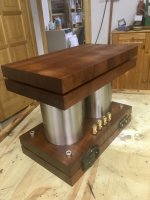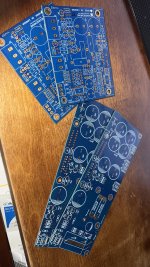I will have a separate PS for each channel, so each PS sees a mono amp. So 4700uF seems enough, right?
How about the ±34V for the rails? I have the transformers with the chassis, so I can not really change that. Is it gonna work?
The chassis is from a gainclone project I made years ago. It's for two monoblocks in 100mm stainless steel tubes. It's a surprising design, and a bitch to work with.
How about the ±34V for the rails? I have the transformers with the chassis, so I can not really change that. Is it gonna work?
The chassis is from a gainclone project I made years ago. It's for two monoblocks in 100mm stainless steel tubes. It's a surprising design, and a bitch to work with.
Attachments
That's a really neat design, though. What are you doing for the heat sink?
±34 V is a bit high as it would be for any other LM3886-based amp. But with the smaller capacitors in the power supply you'll get more droop at higher output power, so it could work okay. The tradeoff there is that once you push past ±32 V with a 4 Ω load the LM3886 will start to engage some of its internal protection circuits on the signal peaks. So the maximum undistorted output power with ±32 V is about 70 W if I recall correctly. But with ±32.5 V it's around 30 W. I recommend ±30 V to have some margin for mains voltage variations and such.
Tom
±34 V is a bit high as it would be for any other LM3886-based amp. But with the smaller capacitors in the power supply you'll get more droop at higher output power, so it could work okay. The tradeoff there is that once you push past ±32 V with a 4 Ω load the LM3886 will start to engage some of its internal protection circuits on the signal peaks. So the maximum undistorted output power with ±32 V is about 70 W if I recall correctly. But with ±32.5 V it's around 30 W. I recommend ±30 V to have some margin for mains voltage variations and such.
Tom
Thanks. For heatsink there is an old CPU heatsink inside, and I would add a fan. There is an air gap between the wooden planks and around the transformers. I wouldn't want to ditch the 2x24 transformers but it also seems like a bad idea to build an amp for world class distortion levels and then overdrive it with rail voltage, doesn't it?
I certainly see it that way. 🙂
A CPU cooler makes sense. They can move a remarkable amount of heat.
Tom
A CPU cooler makes sense. They can move a remarkable amount of heat.
Tom
Finally fully finished my Modulus 86 build! I was able to fit it all in a nice compact case (BRZHIFI BZ2109) 210x90x250. Boards are mounted symmetrically - meaning one is flipped upside down. Allows for nice short wire runs.
Added board that switches power on and off using NE555 and relay. Anti vandal switch with ring LED looks solid.
Input buffers are OPA1656 - I like how they sound. Can be switched back to LM4562 easily since I have DIP sockets installed.
Overall very detailed amp and most important for me - it sounds “musical”!!! while THD is 0.0002 or so!
Added board that switches power on and off using NE555 and relay. Anti vandal switch with ring LED looks solid.
Input buffers are OPA1656 - I like how they sound. Can be switched back to LM4562 easily since I have DIP sockets installed.
Overall very detailed amp and most important for me - it sounds “musical”!!! while THD is 0.0002 or so!
Attachments
-
 IMG_3287.jpeg384.6 KB · Views: 137
IMG_3287.jpeg384.6 KB · Views: 137 -
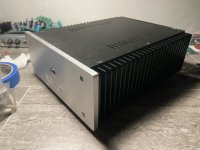 IMG_3288.jpeg370.4 KB · Views: 135
IMG_3288.jpeg370.4 KB · Views: 135 -
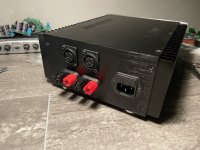 IMG_3289.jpeg447 KB · Views: 157
IMG_3289.jpeg447 KB · Views: 157 -
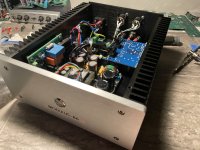 IMG_3280.jpeg459.6 KB · Views: 171
IMG_3280.jpeg459.6 KB · Views: 171 -
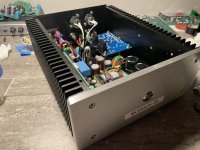 IMG_3281.jpeg463.4 KB · Views: 172
IMG_3281.jpeg463.4 KB · Views: 172 -
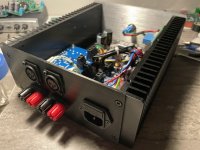 IMG_3282.jpeg410.9 KB · Views: 153
IMG_3282.jpeg410.9 KB · Views: 153 -
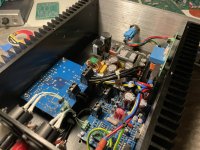 IMG_3283.jpeg555.1 KB · Views: 151
IMG_3283.jpeg555.1 KB · Views: 151 -
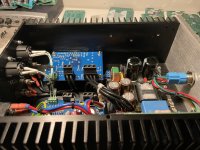 IMG_3284.jpeg476.6 KB · Views: 165
IMG_3284.jpeg476.6 KB · Views: 165 -
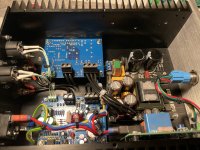 IMG_3285.jpeg583.5 KB · Views: 156
IMG_3285.jpeg583.5 KB · Views: 156 -
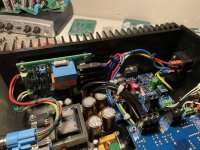 IMG_3286.jpeg522.6 KB · Views: 160
IMG_3286.jpeg522.6 KB · Views: 160
Last edited:
The connectors for the power supply and output are 21.5 mm in height.
I ordered the boards and checked the BOM. The power connectors you picked are actually 26.6mm tall. I need to replace them with Molex.
Happy 10th anniversary, Modulus-86!

To celebrate ten years of Modulus-86 I designed something truly unique and special. The PCB was redesigned from the ground up. And unlike all my other circuits, the 10th Anniversary Edition of the Modulus-86 uses one unobtanium part, the OPA627 in two DIY-friendly package options: The TO-99 metal can and DIP-08. The OPA627 is very well regarded in audio circles, but current production parts are only available in surface mount, which turns off many DIYers. So when I came across a stash of NOS OPA627 in TO-99 and DIP-08 I knew exactly what I'd use them for. They were not cheap, but I believe they were worth it in the end.
The 10th Anniversary Edition is a drop-in replacement for Rev. 3.0 of the Modulus-86, making upgrading a breeze. Compared to Rev. 3.0, the 10th Anniversary Edition features a cleaner transient response and a smidge higher output power, especially with a 4 Ω load.
Because it uses rare parts, the 10th Anniversary Edition will only be available as a limited edition stereo kit. I have 25 kits available with the TO-99 and 65 kits with the DIP-08. Once they've sold there will be no more.
You can find the Kit here: https://neurochrome.com/products/modulus-86-10th-anniversary-edition
... and the build video for it here:
Tom
To celebrate ten years of Modulus-86 I designed something truly unique and special. The PCB was redesigned from the ground up. And unlike all my other circuits, the 10th Anniversary Edition of the Modulus-86 uses one unobtanium part, the OPA627 in two DIY-friendly package options: The TO-99 metal can and DIP-08. The OPA627 is very well regarded in audio circles, but current production parts are only available in surface mount, which turns off many DIYers. So when I came across a stash of NOS OPA627 in TO-99 and DIP-08 I knew exactly what I'd use them for. They were not cheap, but I believe they were worth it in the end.
The 10th Anniversary Edition is a drop-in replacement for Rev. 3.0 of the Modulus-86, making upgrading a breeze. Compared to Rev. 3.0, the 10th Anniversary Edition features a cleaner transient response and a smidge higher output power, especially with a 4 Ω load.
Because it uses rare parts, the 10th Anniversary Edition will only be available as a limited edition stereo kit. I have 25 kits available with the TO-99 and 65 kits with the DIP-08. Once they've sold there will be no more.
You can find the Kit here: https://neurochrome.com/products/modulus-86-10th-anniversary-edition
... and the build video for it here:
Tom
What is the difference between opa627 that are in to-99 metal can and dip-8 plastic? Is one better then the other? measurements? sound?
Metal can looks really good in my opinion…
Metal can looks really good in my opinion…
I would ask the same about the SMD version of the opa627. Does it sound significantly different, or measure significantly worse/better than the discontinued packages?
I have a collection of circuit boards for other amps that I was going to build, but after using the Modulus for several months I decided I don't really need a different amp. Now suddenly I feel like I do need a different amp.
Sorry I can't delete my post above, never mind - I'm assuming a SMD to DIP board will work successfully. I'm ok with going that route too.
- Home
- Vendor's Bazaar
- Modulus-86: Composite amplifier achieving <0.0004 % THD+N.
